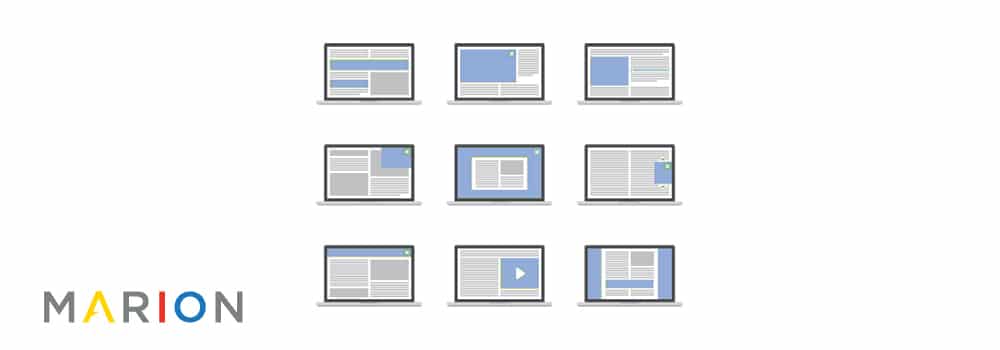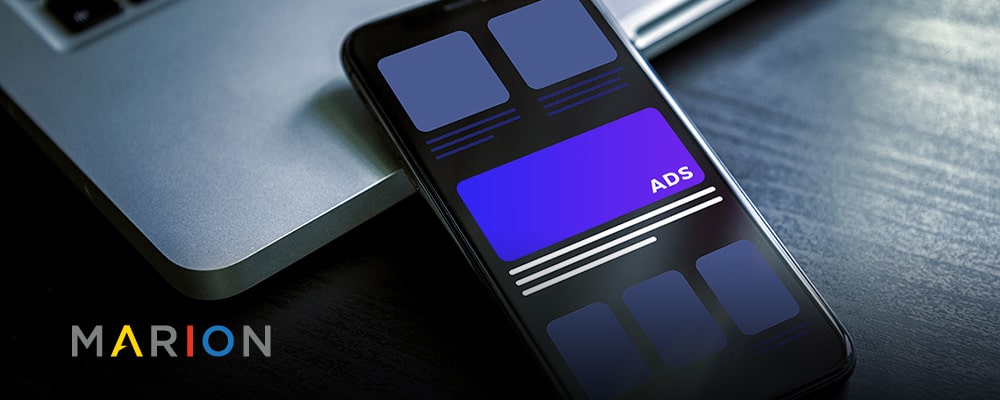Display ads are an incredible way to capture the attention of your audience in a visually appealing way, increasing visibility and maximizing exposure. As Google boasts, you can reach 90% of Internet users worldwide through the Google Display Network.
You can use display ads to increase brand awareness to those who may not have heard of you before or drive consideration by re-marketing to those who have previously visited your site. At MARION, we find that combining PPC in Houston with display re-marketing drives exceeding good results. Through Google, you can run different display ads, though responsive and static image ads are the two most common display ad types.
So, what are Google responsive ads for display? What are the differences between responsive ads vs. image ads? And what do you need to know in order to create an effective and well-performing Google responsive display ad?
What Are Google Responsive Ads for Display? – Responsive Ads vs. Image Ads
Responsive display ads are the new default ad type on the Google Display Ad Network, effectively replacing static image ads, though static image ads are still available if you choose to implement them.
Image Sizes
Google responsive display ads differ from their static counterparts in that responsive ads automatically adjust their size and format to fit available ad spaces. With static image ads, on the other hand, you must create ads of different sizes in order to fit multiple ad spaces. In other words, if you don’t invest in numerous display ads of all different sizes, you simply will not get as much visibility.
There are also more elements associated with responsive display ads. With static display ads, you simply had to input a final URL and upload your images. With responsive display ads, on the other hand, you can upload up to 15 images for a single ad from which Google can choose.
Headlines
You can also include up to 5 regular headlines, one long headline (up to 90 characters), and up to 5 descriptions. With this, you can add more value and context to your ads than you were able to previously.
CTAs
Google also allows you to add call-to-action buttons outside of your image with responsive display ads. These typically appear as a button on some ad formats. You can select from 12 different preset options that range from “Learn More” to “Get Quote.” You can also select the (Automated) option, which allows Google to select the call-to-action text for you. This is a feature that was not available before with static image ads. These CTA buttons are great because they eliminate your need of having to include a CTA button in your image, and still encourage people to take action.
Google Ads Responsive Display Ads Specs

As we mentioned before, Google has simplified the design process for responsive display ads. Rather than working through a rather lengthy list of supported Google responsive display ad sizes, now you simply upload 2 different sizes: a 1200 x 628 image and a 600 x 600 image (dimensions in pixels).
Though Google allows you to upload up to 15 images for a single ad, you are only required to upload one landscape image and one square image per ad.
With responsive display ads, you do not need to include your logo in the image itself as that gets added separately when you’re setting everything up. You are encouraged to include one square logo (128 x 128 pixels or greater), and one landscape logo (1200 x 300 pixels). Opt for a logo with a transparent background if possible, as those tend to get the best results.
Benefits of Using Responsive Display Ads
With responsive display ads, you get a number of added benefits, on top of all of the benefits that static image ads provide. Given the fact that responsive display ads are able to reformat themselves to fit any number of different ad spaces, you get a lot more visibility than you typically would with a static image ad.
Since you also add headlines and descriptions to accompany the image, you can provide users with more context in which to encourage them to click on your ad. This results in higher-performing ads. It also allows Google to rotate and optimize for the combination that generates the best results, which also plays a part in generating better results. You can even repurpose the best headlines when you advertise using pay-per-click in Austin (and vice versa).
Another huge benefit to responsive display ads lies in the fact that they take less time to design. Rather than wasting time formatting all the different ad sizes as you were required to do with static image ads vs. responsive ads, with responsive display ads, you only need 2 different ad sizes.
How to Create Responsive Display Ads
When it comes to designing the ads, make sure that the main message/value proposition that you want to get across is the one that is featured in the image. The headlines and descriptions are there to help provide context to the image, but it is the image that will capture people’s attention first.
To summarize the sections below:
- Represent your value proposition in the image if possible
- Adhere to the 20% rule
- Remember that Google can crop 5% horizontally
- You can add CTA buttons in ad text (they don’t need to be in the image)
- Your headline and destination page content should align
- Use previous campaigns to generate the top headline combinations
You should also ensure that you are adhering to the 20% rule, where no more than 20% of the image consists of text. If you exceed this 20% limit, your ad may still get visibility depending on your audience and targeting parameters; but your ad will be limited and you will not capture as many clicks and impressions that you would have been able to capture by adhering to the rule.
Keep in mind that Google may crop the image horizontally – up to 5%. Make sure you have a margin around your image, so your text doesn’t get cut off.
As we mentioned before, you can add CTA buttons to your responsive display ads, so you do not need to include them in your image if you find that your image is too text-heavy. In order to add this feature to your responsive ads, make sure you click on the blue “More Options” hyperlink near the bottom of the setup page and check off the “Call to action text” option.
When it comes to selecting the appropriate headlines and descriptions, look at the content of the page to which you want to drive traffic. Though display ad quality scores are not calculated the same as Search ads, Google does still look at how relevant the landing page is in comparison to the text in your headlines and descriptions. The more relevant your ads are to the landing page, the higher the expected CTR and the lower the CPC of your ads.
If you are currently running text ads or have run them in the past few months, review those as well. See which ads have the highest click-through rates and analyze the highest performing ones to determine headlines and descriptions that people tended to like and click on the most. The more headlines and descriptions that you can include in your Google responsive display ads, the better the ad is likely to perform.
Responsive Display Ads Examples

Below are just a few examples of some responsive display ads that MARION has run in the past. As you can see, Google was able to reformat the image to fit a completely different ad space and create a few different options from the headlines and descriptions that we created.
MARION Provides High-performance Paid Ads for Texas-based Businesses
Executing and optimizing for a successful display campaign is no small feat. If you are interested in getting started with Google display ads or other forms of digital marketing in Houston, reach out to the experts at MARION.
Contact us online to schedule a free consultation with one of our marketing experts today!
